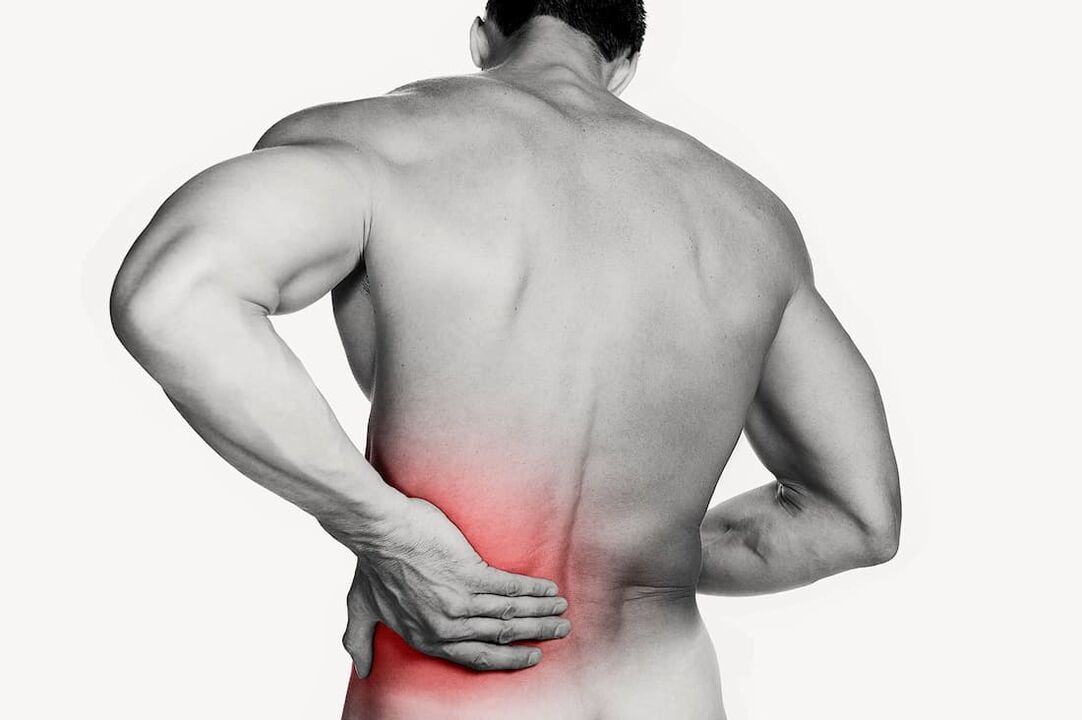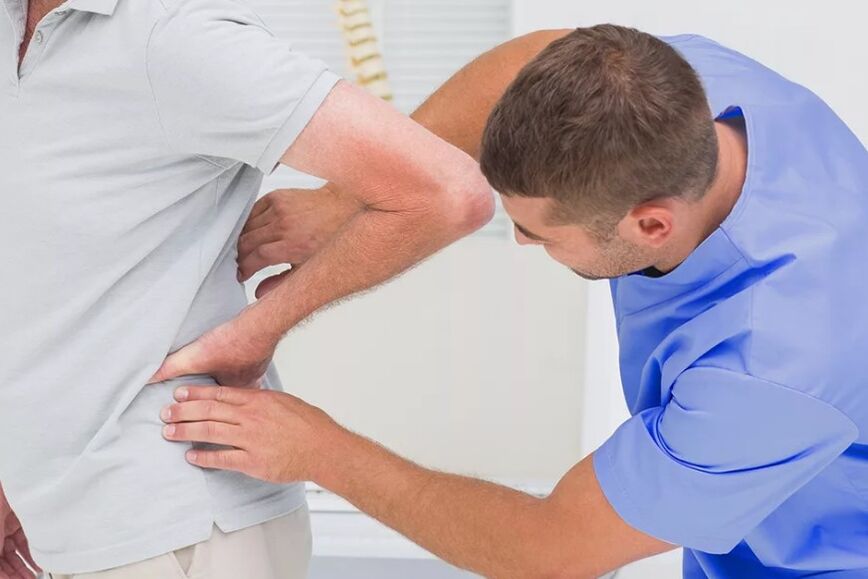
Low pain is the symptom that is rarely paid.Most people associate him in a sitting position, with weight lifting or osteochondrosis, and is in no hurry to seek medical attention.In fact, this condition may indicate the diseases of the kidneys, liver or intestines, and problems with muscle bone system do not survive in themselves.Only timely control and complete examination will help identify the cause of the pain and choose the right treatment.
General information
The lower back is an area that has a significant load in an upright position.The spinal column is represented by five large vertebrae, which are also confirmed by the muscle frame.In this area, 9 of the 10 cases of pain are provoked precisely the pathology of the muscle bone system: osteochondrosis, muscle cramps, intervertebral disk, and tightening of the nerve root.
The remaining 10% of the cases are associated with diseases of the internal organs on the lower back: kidneys, urogenitinic system, intestines, liver.Even a doctor, when examined, can not always determine the cause of the pain, so this condition requires a thorough laboratory and instrumental diagnosis.
Types of pain
The first thing the doctor asks is the nature of feelings.Depending on the cause that causes it, the lower back pain may be:
- Acute: usually sharply, characterized by high intensity;Sensations are up to 1.5 months;
- Subakut: It takes 6-12 weeks;
- Chronic: a feeling of any intensity that lasts at least 12 weeks;
- Transmission (variable): appears periodically;
- sore;
- dumb;
- Strong, average intensity, weak.
This class is conditional.Depending on the situation and the circumstances, the nature and duration of feelings may vary.It is important to describe them as fully as possible.
Reasons
The reasons that cause the back to the back in the back.Most often the provocative factors serve:
- hypothermia;
- weight-lifting;
- uneven load distribution (background of pregnancy, posture disorders, pathology of muscle bone);
- infectious injury;
- disease of the muscle system;
- inflammatory processes including autoimmune;
- Long stay in an uncomfortable position;
- Change in bone tissue composition (osteoporosis);
- Volumetric processes: benign and malignant tumors, abscesses;
- hormonal changes (menstruation, pregnancy, menopause);
- kidney disease (urolithiasis, pyelonephritis, glomerulonephritis, abscesses);
- Pathology of the stomach tract;
- Diseases of the uterus and appendices in women, men prostate, etc.
Illness
Low pain can be a symptom of the muscle bone system and various diseases of the internal organs.The doctor's main task is to find out exactly what caused the condition to deteriorate and take the necessary measures.
Here are the most common pathologies.
Ankylosing spondylitis
This is a systemic inflammatory disease in which each vertebrae occurs in a single conglomerate.At the same time, the spinal stabilizing ligaments are calcium pads, which results in the affected area almost completely losing mobility.
The distinctive properties of lower back pain in anchilosis spondilitis are as follows:
- increasing intensity at rest, especially with extended statements in the horizontal position;
- Restriction of movement in the lumbar region;
The lumbar spine osteochondrosis
This is a very common disease in which periodic plates are thinner and play the role of shock absorbers.As a result, nerve roots and cramps in the surrounding muscles cause severe pain.At the late stage of the disease, the intervertebral disk is formed, which can press on the spinal cord, increasing the pain.
In the case of osteochondrosis, the pain increases:
- when raised from a sitting or horizontal position;
- When trying to lie down on his stomach;
- With tendencies.
If the disease causes a huge hernia, the pain in the lower back is often accompanied by numbness and weakness of one or both legs.
Curvature of the spine in the lumbar region (kyphosis, skoliosis)
In this pathology, pain occurs in the middle and late stages of the disease.The discomfort usually occurs at the end of the sun and often involves the fatigue of the spinal muscles.Pain is more commonly caused by cramping of the muscles of the spine, and the muscles (the upper and lower limbs of the lower and lower limbs can be discovered when removal is removed.
Spondylarthosis
It is a degenerative-given disease of cartilage that covers intervertebral discs.Gradually thinner and destroyed, the growth of bones (osteophytes) appears in the lesion area.The distance between the vertebrae, the spinal canal narrow, the nerve roots and the spinal cord irritated.
Pain with this pathology:
- increases after load (long -term stay in a constant position, walk) and relaxation;
- with the stiffness of the movements, first in the morning, then constant;
- It can be given to the thigh and the hip joint.
The muscles in the lesion area are cramped and are constantly tension, which also increases the pain.
Urolin disease
The attack of urolithiasis is characterized by severe lumbar pain in the kidney affected.However, the sensations do not change depending on the pose, one does not find a position in which they weaken at least a little.The attack is often accompanied by reducing urine and changes in color.
Low pain may be the result of:
- algomenor (painful menstruation);
- pregnancy;
- pancreatitis;
- osteomyelitis;
- bowel obstruction;
- Appendicitis, etc.
Pain in different parts of back
Localization of pain can say a lot about their cause.Consequence may be pain in the upper part of the lumbar region:
- spinal diseases;
- injuries;
- muscle cramps in the background of the surge;
- cardiovascular disease;
- tumors;
- Diseases of the stomach tract.
If the epicenter is located in the lower back, a list of probable causes outside the spinal diseases:
- kidney pathology (pyelonephritis, urolithiasis);
- bowel interruption (constipation, bloating);
- cramps or inflammatory process in pelvic organs (salpingoophorite, endometritis);
- In particular, physiological causes of pregnancy;
- Pinching the sciatic nerve.
Moving the pain to the right or left may indicate the lesion of the spinal cord, the kidneys.
Diagnosis
Diagnosis of lower back pain requires a comprehensive examination.The first phase of the reason for the reason is the survey.The doctor clarifies:
- Localization of pain;
- character and duration;
- Causing an attack or pain causes;
- Conditions in which the condition improves (a certain pose, mobility, drug taking, etc.).
Data on injuries and illnesses, data on already identified chronic pathologies are collected without failure.The Doctor decided that additional possible diagnostic searches include the following:
- General testing of blood and urine: helps identify the body's inflammatory process, kidney pathology;
- Biochemical blood test for kidney damage, pancreas, liver and gallbladder, etc.
- Ultrasound of the abdominal organs and pelvis, men - ultrasound of prostate;
- Ultrasound of the kidneys;
- Lumbar spine radiography, CT or MRI;
- X -tumor of the chest.
In the case of suspected review diagnosis and after -inspection pathology, more targeted tests, examination and consultation of narrow professionals are prescribed.These allow you to clarify or refute the diagnosis.

Treatment
Treatment of pain on the lower back depends on the cause.A neurologist, urologist, gynecologist and surgeon can participate in pathology.When it comes to muscle bone diseases, doctors use medical, non-drug and surgical methods to improve the patient's condition.
Drug treatment
The most common tool for eliminating lumbar pain is non -steroid anti -inflammatory drugs (NSAIDs).These are prescribed for topical use in tablets, intravenous and intramuscular injections, rectum suppositories, and creams, ointments and plasters.The decision on the dosing of the product and the duration of the course is made by the doctor, as the uncontrolled use of these drugs can cause unpleasant side effects.
If NSAIDs are ineffective, doctors prescribe hormonal drugs (corticosteroids).They stop the inflammatory process and help the pain.
A third group of drug patients that improves the condition of the patient.Muscle cramps are removed at the lower lower part.
In addition, they can be appointed:
- decongestants to reduce the edema of the pinch root;
- Vitamins B to improve nerve management;
- Restants.
No -drog methods
Nem -Drog treatment complements medical systems.Depending on the clinical situation, this may include:
- physiotherapy procedures (magnetic, laser effect, electrophoresis, etc.);
- Physiotherapeutic exercises: the course of exercises has been developed separately -in accordance with the main and related diseases;The tournament should be affected regularly, not only in the clinic office, but also at home, only in this case;
- General reinforcement and therapeutic massage (apart from aggravations);
- acupuncture;
- Manual therapy and assistance to osteopath.
Surgery
The surgeon needs help if the general image explores one of the indications of surgical treatment.The presence of intervertebral disk hernia does not indicate surgical treatment, regardless of size.Depending on the signs, doctors can remove the intervertebral disk hernia, eliminate the compression of the spinal cord roots, remove the tumor, etc.
Prevention
The most effective way to prevent lower back pain is to adjust the lifestyle to save the kidneys, spine and pelvis, but if the pain is often caused, this may be due to the extraordinary attraction of professionals:
- Avoid hypothermia;
- prevent hypodynamia;
- to exercise at amateur level (swimming is particularly beneficial on the condition of the spine and the back muscles);
- Properly and balanced for eating: prevents overdose, minimizes fatty, spicy, too salted foods;
- except for alcohol and nicotine;
- Drink at least 1.5 liters of clean water a day without taking tea, coffee or juice;
- Keep the body weight index at normal level: excessive weight does not affect the state of the spine and the deficiency can cause respect for the kidney.
If a person has already diagnosed the pathology of the muscle system, preferably at least twice a year, according to European recommendations on rehabilitation of the pathology of the spine, to go on preventive courses, according to the doctor's appointment.






















